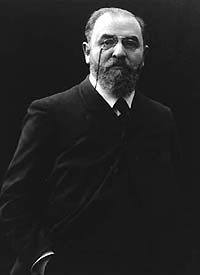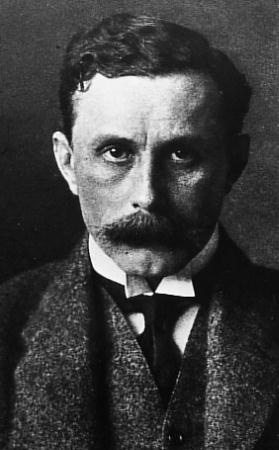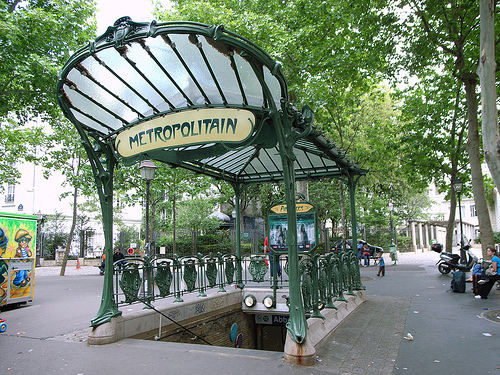Hello and welcome to my blog featuring posts and updates of my Architecture History course. I am a junior enrolled in the College of Architecture and Planning at Ball State University. The Architecture History course covers a broad range of historical architects and buildings of the past and how these examples and principles have contributed and continue to shape our current modern way of design.
The nature of this blog is meant to be affable yet at the same time serious and informative. The variety of content will be composed of opinion and observation, but more importantly factual material gathered from textbooks, articles, and online sources.
Today's Blog focuses on the differences and similarities of three historic architects of the late 1800's:
John Ruskin, Gottfried Semper, and Viollet le Duc.
John Ruskin had a stronger tie to nature than the other two architects. He grew up in London, England practicing the art of painting and other fine arts. (Arts and Crafts) He was raised as a Christian, which affected his thinking and can be seen as a result in many of his books. After graduating he was given the opportunity to teach the fine arts back at his alma mater, Oxford University. He stayed close to home his entire career really developing his ideas and perception of art in all forms including but not limited to painting and architecture. He felt that it was wrong to cover up a material and hide it, but rather the material was to be presented as itself; after all his volume of “Modern Painters” disputed for ‘Truth in Nature’. This idea carries over into his argument that building restoration “means the most total destruction which a building can suffer: a destruction out of which no remnants can be gathered.” (02 Semper)
He really enjoyed gothic architecture and thought it perfectly embodied the art of nature. He further wrote his book “The Seven Lamps of Architecture” which featured these virtues most likely developed from his Christian upbringing: Sacrifice, Truth, Power, Beauty, Life, Memory, and Obedience. With all this said, Ruskin used his artistic ideologies to start the Arts and Crafts Movement in England as a resistance against the ever-growing use of mechanized goods in England and America. With the Industrial Revolution making its mark on society and architecture “He believed, along with Morris, that handwork and craftsmanship brought dignity to labor” (Arts and Crafts) and machines were diluting this dignity.
Gottfried Semper had a very adventurous life that took him to many places around Europe. He grew up in Hamburg, Germany studying mathematics and wanted to be an engineer, but that fell threw for him. He also decided to join the military, but fled Hamburg to avoid a warrant out for his arrest for a duel that he was in. (02 Semper) He traveled to different parts of Germany and even to Paris learning and cultivating his ideas about society, mathematics, and design. He was involved in archeological digs in Italy and Greece, was part of the Beaux-arts era of architecture and design, and had his own ideas about religion often feeling the church was corrupt. He met up with many of the great minds of the time including Wagner and Charles Darwin.
When he was given the opportunity to design the Hoftheater in Dresden, Germany many commissions opened up to him after that. An interesting fact is that the theater caught fire and burnt down and the people loved it so much that they sent for Semper to come rebuild it. With his warrant still out he sent his son in his place to restore the large opera house.
As he began writing books such as his most famous “The Four Elements of Architecture” he brought his knowledge of mathematics to the table. He tried to relate design and style as mathematical formulas assigning different aspects of design such as function, technique, and materials as variables in an equation. He believed that a building should always show its structure. He further took the idea of the primitive hut and expanded it to four parts: The hearth or social outlet, the substructure, the roof, and then the enclosure or walls. His idea that the roof and structure are one continuous element and the enclosure was separate led to the concept of the Curtain Wall.
Later he found that “architecture everywhere borrowed its types form pre-architectural conditions of human settlement.” When designing he incorporated Polytechnics, where he used multiple styles of architecture from the past in one building. For example, his opera house in Dresden has many elements that reflect work that Palladio did back in the 1500’s.
Viollet le Duc was considered one of the last great theorists. He was influenced by nature and “All products of nature have style since they follow inflexible laws. The form of the bird’s nest or of the flower is determined by organic principles, governed by both the function of the object and the nature of the material from which it is made” (Bersanni 339). Le Duc’s career consisted of several building restorations often imparted by the king of France himself. Le Duc had the ability to look at the past and figure out what the intent of the designers back then were and take those principles and expand on them with his own ideas. In one of his lectures he gave he said there is no invention “We must necessarily have recourse to the past in order to originate in the present.” (Memory 43) He tried to be very scientific about his work and focused on the tectonics of architecture. He was fascinated by gothic and neo-gothic architecture and believed that it surfaced because of its sturdy structural system to reach higher, rather than its detailed aesthetics.
His work as a restoration architect was rooted in the king Napoleon Bonaparte the Second’s interest in him. The fortress of Carcassonne in France was destroyed during Napoleon the First’s era. Le Duc’s idea of restoration was not to make an exact render of the original structure, but rather take the foundation and build upon it using new materials, principles, and ideas to make it greater than the previous structure. In doing so he had different masonry and roofing material. He used slanted roofs and different spires, only used in the north so the building was out of context with the surrounding southern area.
Another work the king had him restore was the castle of Pierrefonds, which was partially destroyed to get revenge on the family there from the king himself. The king wanted it to be restored so that he could use it as his own imperial palace. On this neo-gothic castle he incorporated a lot of polychrome, which simply means color. He was experimenting with using color as a way to decorate a façade rather than detailed ornamentation in normal gothic.
Viollet le Duc was very influential and had many people study him as inspiration for their own work, such as his addition of iron into masonry structure and it being exposed instead of hidden, his custom made iron candlesticks in the cathedrals, and Antoni Gaudi studies.
These three architects and theorists contributed much to our design profession, the way we begin the process, how we interpret past examples, and if were to practice building restoration. I mention the last point specifically because during their era they implemented the idea that when restoring a building one uses different material or colored masonry units to show the difference between the original and new context.
Although some of them wouldn’t agree on every topic they all agreed on a few. They were influenced by each other with books, by other theorists at the time including Darwin, even musical composers like Wagner. By interpreting architecture and the past they each took their own spin on design and art persuading one another. Each made it their responsibility to contribute books and buildings to society at a time when knowledge was marveled at. Viollet le Duc studied and defined terms in his own dictionary, others were social activists. Some stayed in the same area their whole life taking in what was around them and following the status quo so to speak like John Ruskin while others like Gottfried Semper traveled all over Europe taking in each culture and design principles.
On the other hand, they didn’t agree on everything. John Ruskin’s ideas about building restoration were very far from le Duc’s. He thought that if a building was destroyed it should be left alone, and not be built up again whether the same or completely different because this wasn’t honest and isn’t the work of the restorer. Not only did they have views on design, but also social issues: Ruskin did not agree with the capitalism movement due to its disregard for failing to realize the complexities of the human, Semper was against the socialistic views of society, etc. Semper and le Duc both agreed that it was wise to look to the past to find inspiration for present design work. All three referred to nature for inspiration.
In conclusion, modern architecture couldn’t have emerged without these ideas and principles!
Architecture Viollet-le-Duc. Academic Slides. Arch 329. Ball State University. College of Architecture and Planning. Accessed September 5, 2011.
02 Semper and Ruskin. Academic Slides. Arch 329. Ball State University. College of architecture and Planning. Accessed September 5, 2011.
Memory as Construction in Viollet-le-Duc’s Architectural Imagination. Academic Electronic Article. Paroles Gelees Volume 16.2 1998. Ball State University. College of architecture and Planning. Accessed September 5, 2011.
Bressani. Viollet-le-Duc’s Philosophy of History. Academic Electronic Article. Accessed September 5, 2011.





 Another member of this Werkbund team is Victor Bourgeois who designed house number ten. This is simply a three story single family residence. It seems that most of the Werkbund contestants took some form of grid or structure and would pattern it or offset it slightly so that the grid was still evident, but there was one portion or multiple portions that stood alone to be expressed or somehow compliment the other forms. If you will notice in the diagram the light blue section is shifted down, reminding me of two tectonic plates shifting against each other. There is a reference to the three by three grids in plan, but the wall planes do not follow the grid exactly making me wonder if this is intentional or if Bourgeois just placed them around there where they were convenient. If the grid did fit up perfect would it not cut down on construction cost and labor? Another question comes to mind, were the architects in the Weißenhofsiedlung given a program including exact restroom and appliance dimensions? The reason I bring this up is to say that if they had complete liberty and didn’t have to follow a rigid program then why not move the wall that is one foot away from fitting to the grid over? It is apparent that although it doesn’t fit the grid perfect it does fit rather well to the three vertical rectangles in which I mentioned the shift action previously. The blue section of the plan deals with circulation and main public spaces while the other two (violet and crimson) split the kitchen, restrooms, and sleeping quarters.
Another member of this Werkbund team is Victor Bourgeois who designed house number ten. This is simply a three story single family residence. It seems that most of the Werkbund contestants took some form of grid or structure and would pattern it or offset it slightly so that the grid was still evident, but there was one portion or multiple portions that stood alone to be expressed or somehow compliment the other forms. If you will notice in the diagram the light blue section is shifted down, reminding me of two tectonic plates shifting against each other. There is a reference to the three by three grids in plan, but the wall planes do not follow the grid exactly making me wonder if this is intentional or if Bourgeois just placed them around there where they were convenient. If the grid did fit up perfect would it not cut down on construction cost and labor? Another question comes to mind, were the architects in the Weißenhofsiedlung given a program including exact restroom and appliance dimensions? The reason I bring this up is to say that if they had complete liberty and didn’t have to follow a rigid program then why not move the wall that is one foot away from fitting to the grid over? It is apparent that although it doesn’t fit the grid perfect it does fit rather well to the three vertical rectangles in which I mentioned the shift action previously. The blue section of the plan deals with circulation and main public spaces while the other two (violet and crimson) split the kitchen, restrooms, and sleeping quarters. 




















